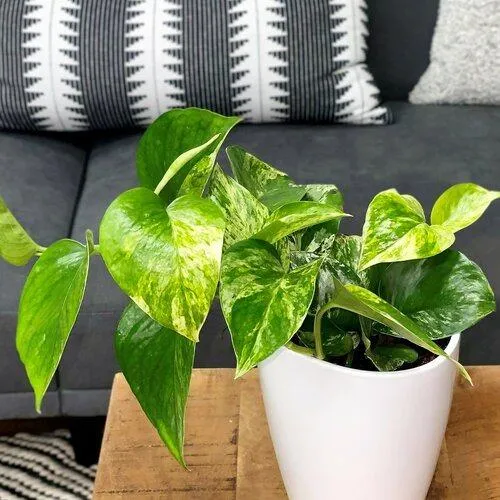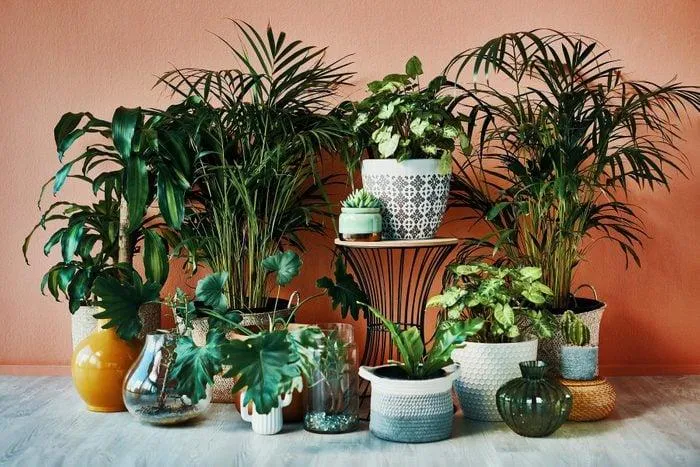The Best Indoor Hanging Plants for Any Space
Wondering which indoor hanging plants would work well in your home? From my experience as an avid plant parent, hanging plants are an easy and aesthetically pleasing way to add greenery to any room. In this article, I’ll cover the top hanging plant options for indoors and provide tips to help you choose types that will thrive in your conditions.
Pothos
Pothos, or devil’s ivy, is one of the hardiest and most forgiving hanging plants you can get. I’ve had pothos plants going strong for years with little care. They thrive in low to medium light and don’t mind being overlooked occasionally when life gets busy. Pothos comes in various leaf color variants like golden, marble queen, and neon. Whichever variety you choose, its trailing vines will fill out a hanging basket beautifully. Pothos is practically impossible to kill, making it a great choice for beginners.
Philodendron
Similar to pothos, philodendron is an excellent indoor vine that comes in many varieties. Heartleaf philodendron has lovely heart-shaped leaves and grows quickly. Philodendron hederaceum, also called Swedish ivy, has smaller leaves edged in green or cream. These philodendrons prefer medium to bright indirect light. They do well hung near a sunny window. Like pothos, philodendron can go longer between waterings and forgive neglectful owners. From my experience, philodendrons tend to grow more vigorously than pothos.

English Ivy
With its small dark green leaves that stay planted throughout winter, English ivy lends itself well to hanging baskets. It thrives in medium to low light and handles low humidity. English ivy grows rapidly into a full, lush container. Just be mindful not to overwater, as soggy soil can cause leaf drop. Direct sun or drafts may also cause leaf browning, so monitor its conditions. Overall, English ivy makes for a low-maintenance, foolproof option.
Spider Plant
Spider plants are renowned for their hardiness and ability to thrive in several light levels. With strappy green leaves and white blossoms that produce baby plantlets, spider plants lend a casual charm. I enjoy watching the plantlets form at the end of each leaf. They prefer bright indirect light. Be sure not to overwater spider plants, as their roots are more prone to rot in constantly damp soil. Let the soil dry out between waterings. Spider plants purify indoor air, making them a great choice for busier spaces.
Wandering Jew
Also called inchplant or purple heart, wandering Jew trails gracefully in hanging baskets with its colorful foliage. It comes in various hues like pink, white, red, and green. Wandering Jew prefers medium to low light. While the leaves hold their color best in bright spots, too much direct sun may cause scorching. I find wandering Jew spreads quickly into a full hanging planter. It’s a stunning conversation piece that thrives on neglect.

Chinese Evergreen
With its lush foliage accented by dark green splotches and cream or pink variegation, Chinese evergreen adds elegant texture. It prefers medium to bright indirect light. Take care not to overwater Chinese evergreen, as soggy soil causes root rot. Allow the soil to partially dry between waterings. It enjoys high humidity but can tolerate normal home conditions. Try hanging a Chinese evergreen where you’ll notice its subtle beauty daily. From my experience, they make wonderful desk or bookshelf plants too for a pop of color.
Nephthytis
Also called fishbone fern or florist’s nephthytis, this trailing fern has delicate lacy fronds resembling a “fishbone.” It grows best in bright indirect light for vibrant foliage. Nephthytis prefers consistent moisture but not soggy soil. I keep the surrounding soil lightly moist. A fishbone fern hung near a kitchen sink or bathroom maintains humidity from your daily activities. It’s a very beautiful, low-maintenance fern great for any room.
Fittonia
Fittonia, sometimes called nerve plant, has heart-shaped foliage in peachy pinks, white variegation, or deep reds depending on variety. It thrives in medium to low light. However, the brighter the light, the more vibrant its color. Monitor moisture closely for fittonia – it wilts dramatically if soil dries but recovers with watering. High humidity benefits it too. I think fittonias look so striking when their leaves contrast brightly against dark hanging planters or walls. Their colors really stand out!

Now that you know some top hanging plant options, how do you choose the right types for your space? Here are a few things to consider:
- Light levels – Assess windows and how much indirect sunlight reaches planting areas. Choose plants matched to those conditions.
- Water needs – Some prefer evenly moist soil while others need more dry-out time. Match your plant care habits.
- Aesthetic appeal – Do you want more foliage texture? Colorful leaves? Consider visual impact.
- Care needs – Consider your schedule. Forgetting water occasionally is ok for hardier plants but not wilting-prone types.
- Budget – Some vining plants like pothos are very inexpensive while others have higher price tags. Factor cost into choices.
Don’t worry if you kill a plant – it happens to the best of us plant parents! Kinda part of learning what works. I once thought fittonias were low maintenance until every single one sighed its last breath. Kind of makes gardening interesting, right? Now I know their diva-like care needs better. Keep trying different plants until you find your green thumbs.
Once you’ve selected hanging plant types suited to your space, follow these tips for healthy container gardening:

- Use pots with drainage holes for proper water flow.
- Use a well-draining potting mix like cactus soil, perlite, orchid bark or coir for aeration.
- Water thoroughly until drainage occurs, then discard excess in tray below to avoid soggy soil.
- Fertilize monthly in spring and summer with diluted liquid plant food.
- Repot when roots emerge from holes to promote new growth.
- Prune foliage or vines to maintain shape and fullness.
- Introduce a humidifier if indoor conditions are dry in winter for sensitive plants.
Give your hanging plants a spot with sufficient light, consistent watering and nutrient-rich potting mix. They’ll reward you with lush foliage and thrive for seasons to come. From my experience, indoor container gardening is one of the most rewarding ways to spruce up a space naturally. I hope these tips help you choose low-maintenance yet impactful hanging plants to fill your home with greenery all year long. Let me know if you have any other questions!
Hope you find an indoor hanging plant type or two that suits your space perfectly. Most of all, have fun decorating your home with living art that also cleanses the air. Even if a plant doesn’t make it, think of the experience gained. Wishing you green thumbs and happyplant parenting!
Planted Facts: Top Indoor Hanging Plants
| Plant Type | Size | Water Needs | Light Needs | Care Level |
|---|---|---|---|---|
| Pothos | Small to Medium | Low | Low to Medium | Easy |
| Spider Plant | Medium | Low | Medium to Bright | Easy |
| Philodendron | Medium to Large | Medium | Low to Medium | Easy |
| English Ivy | Medium to Large | Medium | Medium to Bright | Easy |
| Peperomia | Small to Medium | Low | Medium to Bright | Easy |
FAQ
- What types of indoor hanging plants are good for beginners?
Some of the simplest hanging plants for new plant parents are pothos, english ivy, philodendron, and spider plants. They don’t require a ton of sunlight and can survive long periods without watering. - How often should I water hanging plants?
It depends on the type of plant, but as a basic rule, hangin’ plants need water when the top inch or two of soil feels dry. Certain kinds, such as ferns, prefer to stay moist while others, like succulents, can go longer without a drink. Check the soil regularly and water when it’s parched. - What kind of sunlight do hanging plants prefer?
Most hanging plants do best in medium to bright indirect lighting. Direct intense sunshine could scorch their leaves, yet too little light will cause stretching and legginess. Aim to put plants in a spot that gets natural sunlight for several hours daily, away from super hot western windows. - How do I know if my hanging plant is getting enough light?
If a plant is gettin’ adequate lumens, its leaves should be deep green and it will grow bushy. But if foliage is pale or yellowing, it’s not receivin’ sufficient illumination. You may need to move it to a spot with more natural rays. Over time, you’ll learn to read your hanging plants and know their ideal lighting conditions. - What is the best soil for hanging baskets?
Most experts recommend a potting mix specially formulated for containers. Look for a soil that drains well and retains some moisture too. A good House & Garden brand usually does the trick. Avoid using regular garden soil, as it may compact and not allow for good drainage from the basket. Proper soil helps keep your hanging plants alive and thrive. - How do I care for hanging plants in the winter?
When days grow short and temperatures drop, many hanger plants can nevertheless survive indoors with some TLC. Cut back on watering, move pots to a brighter window, and don’t let the soil get soggy or roots may rot. Check on them regularly to make sure they’re not left high and dry. With proper winter care, your hanging plants might even re-bloom come spring! - What are some low maintenance indoor hanging plant options?
If you have a hectic schedule and not a lot of time for plant chores, pothos, philodendron, spider plants or succulents could basically take care of themselves. They don’t need much water or attention to look good hanging around your space. You may have to prune them occasionally, but otherwise these types will hang in there without too much work from you. - How do I help my hanging plants grow bushier?
As the saying goes – prune it and it will bloom! Trimming leggy vines back to several sets of leaves will cause new shoots to sprout, making for a fuller plant. Rotating pots weekly also prevents leaning towards light sources. You can further encourage bushiness by repotting into a slightly larger container with fresh potting mix every couple years. With a little TLC, your hangin’ plants will fill out nicely.
